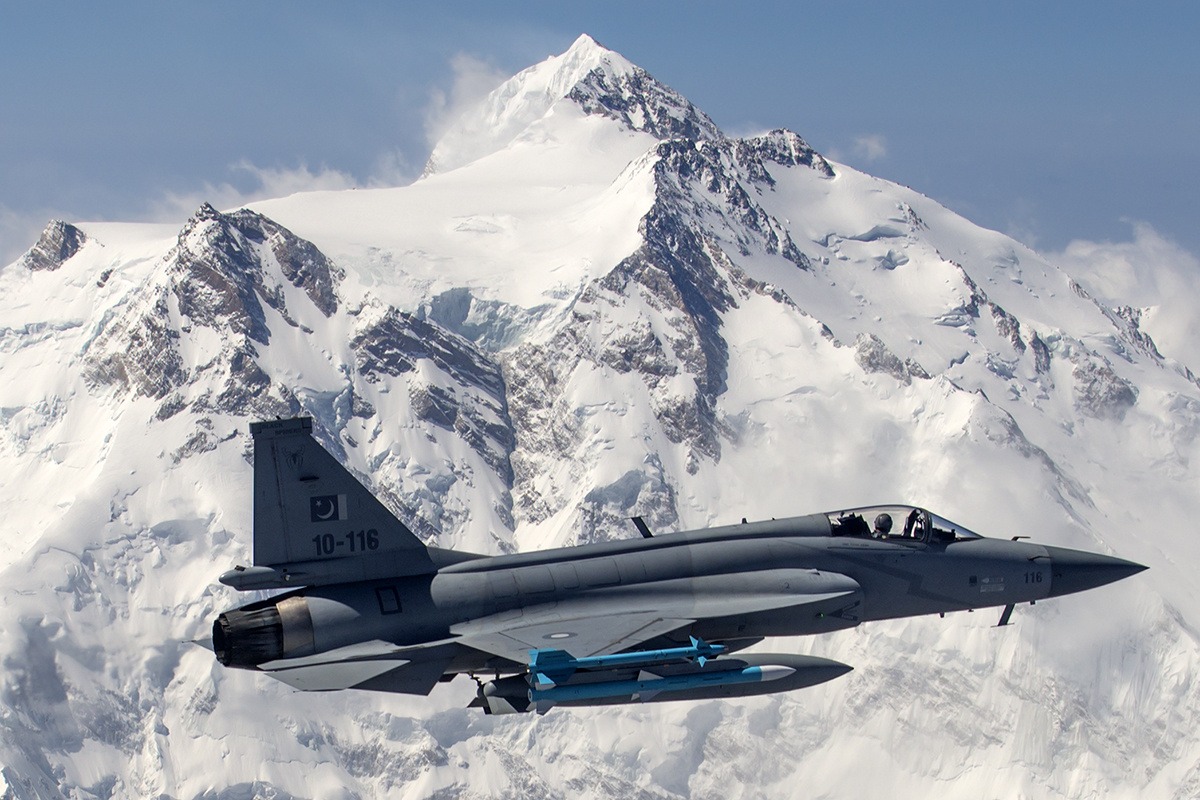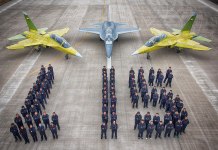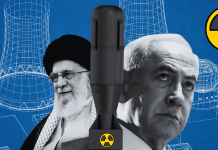A US report indicates that Pakistan’s JF-17 ‘Thunder’ has been seen carrying the Hatf-VIII Ra’ad, an air-launched cruise missile (ALCM). The Pakistan Air Force (PAF) has integrated the weapon on Mirage-IIIR until now.
While the PAF has the US Lockheed F-16A/B, which is the ideal platform for nuclear delivery for various reasons, Pakistan has always been under some end-use restrictions imposed by the US.
The 1960s vintage Mirage is closing toward retirement. The JF-10CE is relatively new to PAF. The JF-17 is the only aircraft with reasonable design command and control with PAF. Perhaps that is the reason for such integration. Coincidentally, both the JF-17 and the Ra’ad are called “Thunder.”
Hatf-VIII Ra’ad
The Hatf-VIII Ra’ad “Thunder” is a Pakistani subsonic ALCM that has been in PAF service since 2012. This 4.85 m long, 0.50 m diameter, 1,100 kg subsonic (below 0.8 Mach) ALCM has an operational range of 350 to 550 km.
The 450 kg warhead can have conventional munitions (ICM), high explosive (HE), or nuclear explosive (NE) warheads. The weapon blast yield is estimated to be between 5 to 12 kilotons of TNT.
The weapon uses the standard inertial, flight-altitude, and terrain-following navigation and has an accuracy of 3.0 m CEP. Officially, the launch platform is Mirage-IIIR. The F-16A/B is also capable.
The weapon was designed and jointly developed by the National Engineering & Scientific Commission (NESCOM) and the Pakistan Air Force’s Air Weapons Complex. Though denied, the technology has flowed from China. The Pakistani military claims the missile is highly maneuverable.
Development testing took place between 2007 and 2016. It is meant to target high-value targets, including command and control centers, radars, surface-to-air missile launchers, ballistic missile launchers, and stationary warships. The second derivative, Ra’ad-II, has an extended range of 600 km.
JF-17 ‘Thunder’
JF-17 Thunder was designed by China and jointly produced by China’s CAC and Pakistan’s PAC, specifically for PAF. China developed this aircraft by combining experience gained from Chinese MiG 21 variants and from J-10, which itself was derived from the abandoned Sino-Israel Lavi project.
The aircraft first flew in 2003 and was inducted into the PAF in 2010. Around 170 of these fourth-generation aircraft have been built and are replacing the A-5C, F-7P/PG, Mirage III, and Mirage V combat aircraft of the PAF. Presently, Pakistan manufactures 58 percent of the aircraft, with the remaining 42 percent produced in China.
The JF-17 is fast becoming the backbone and workhorse of the PAF, complementing the Lockheed Martin F-16 Fighting Falcon at approximately half the cost. The latest variant, Block III, has the Chinese KLJ-7A active electronically scanned array (AESA) radar, a more powerful Russian Klimov RD-93MA engine, a larger and more advanced wide-angle Head-Up Display (HUD), electronic countermeasures, an additional hard point, and enhanced weapons capability. It can carry an FLIR pod. There is an Electro-Optical Helmet-Mounted Sight.
The JF-17 can carry a maximum 3,700 kg payload of air-to-air and air-to-ground weaponry and other equipment mounted externally on the aircraft’s eight hard points (2 × wingtip, 4 × under-wing, 1 × under-fuselage, 1 × chin). All hardpoints communicate via a MIL-STD-1760 data-bus architecture with the Stores Management System, which allows integration of weaponry of any origin. The aircraft also uses Link-17, Tactical Data Link.
The Ra’ad II will be carried on an internal wing hard point. Chinese HD-1A supersonic land attack/anti-ship cruise missile can also be carried.
In July 2015, Myanmar ordered 16 Block 2 JF-17s. In November 2022, it was reported that most of the newly acquired aircraft had been grounded due to structural cracks and other technical issues.
As of April 2024, it was reported that Myanmar’s 11 JF-17 Thunder jets are a major source of tension with Islamabad, as the aircraft have proven unfit for service and are grounded pending their replacement.
Nigeria was the second customer, ordering three planes in 2016. The aircraft are still being assessed operationally, and Pakistan claims that 35-40 may be ordered if found suitable. On 22 February 2024, it was reported that Azerbaijan had signed a contract worth $1.6 billion with Pakistan for the purchase of an unspecified number of JF-17C Block 3.

Pakistan Nuclear Weapons Development
As per the Stockholm International Peace Research Institute’s (SIPRI) latest assessment, Pakistan has 170 nuclear warheads. Pakistan began developing nuclear weapons technology in response to the loss of East Pakistan in the 1971 Bangladesh Liberation War.
It got further impetus after India’s nuclear test, “Smiling Buddha,” in 1974. Finally, on 28 May 1998, a few weeks after India’s second nuclear test (Operation Shakti), Pakistan detonated five nuclear devices under operation named Chagai-I.
China has been repeatedly charged with allegedly transferring missiles and related materials to Pakistan. Reportedly, North Korea had been secretly supplying Pakistan with ballistic missile technology in exchange for nuclear weapons technology.
The low-yield nuclear bombs are fitted on Pakistan’s short-range ballistic missiles for aerial carriage, while the higher-yield warheads are on the Shaheen series and Ghauri series ballistic missiles.
Pakistan has been making efforts to develop new weapons and, at the same time, has a strategy for surviving a nuclear war. Pakistan has built hard and deeply buried storage and launch facilities to retain a second-strike capability in a nuclear war.
Pakistan’s Nuclear TRIAD
Pakistan possesses a wide variety of nuclear-capable medium-range ballistic missiles with ranges up to 2750 km. The 2,200 kilometers range Ababeel Missile has the MIRV capability, technology for which was received from China.
They also have nuclear-tipped Babur cruise missiles with ranges up to 700 km. The Hatf-4 Shaheen-1A is said to be capable of carrying a nuclear warhead. The Hatf-IX Nasr is a solid-fuel tactical ballistic missile with a 60-kilometre range. It is a “Multi-tube Ballistic Missile,” with the launch vehicle carrying multiple missiles. These land-based missiles are controlled by the Army Strategic Forces Command of the Pakistan Army.
The PAF has two dedicated JF-17 Thunder units (No. 16 Black Panthers and No. 26 Black Spiders), each operating 27 aircraft in a squadron. The JF-17 Thunder is believed to be the preferred vehicle for the delivery of nuclear weapons.
These units are part of the Air Force Strategic Command, the command responsible for nuclear response. The PAF F-16s are nuclear-delivery capable aircraft. Pakistan is obliged under the terms of its contract to ask the US for permission before the fighters are converted.
The US has reportedly given both Pakistan and Israel implicit permission to modify their F-16s to carry nuclear warheads. The Ra’ad ALCM, with a range of 350 km, can carry a nuclear warhead with a yield of between 10kt and 35kt.
In 2004, the Pakistan Navy established the Naval Strategic Forces Command. In January 2017, Pakistan conducted a successful launch of the Babur III missile (450 km range) from an underwater mobile platform. It is suspected to have been incorporated with the Agosta 90B class submarine. Pakistan can nuclear-tip the C-802 and C-803 anti-ship missiles and also develop nuclear torpedoes, nuclear depth bombs, and nuclear naval mines.
The first Hangor class submarine, built by China for Pakistan, was launched on April 26, 2024, at a Wuhan shipyard. This was the first of eight submarines of this class that the Pakistan Navy is set to induct into its fleet by 2028. The submarine will be armed with a 450 km range nuclear-capable Babur-3 submarine-launched cruise missile (SLCM), which would complete the Pakistani Nuclear Triad.
F-16s May Suffer Same Fate As Su-27s; Ukraine Fears “Falcons Could Become Sitting Ducks” For Russia
Pakistan National Command Authority (NCA)
The critical decision for Pakistan’s nuclear posturing is the Pakistan National Command Authority (NCA). The NCA is composed of two civic-military committees that advise and console the Prime minister and the President on the development and deployment of nuclear weapons.
It is also responsible for wartime command and control. The main decision-making committees include key senior cabinet ministers as well as the respective military chiefs of staff.
The chairman of the Joint Chiefs of Staff Committee is the deputy chairman of the Development Control Committee (DCC), the body responsible for weapons development and oversight. This body includes the nation’s military and scientific leadership but not its political leadership. With a civilian external façade, the military de facto takes the final calls.
Pakistan’s Nuclear Weapons: Proliferation & Security Issues
While Pakistan has taken several steps to enhance nuclear security in recent years, the instability in Pakistan has called the extent and durability of these reforms into question.
Essentially, there are two major concerns about Pakistan’s nuclear weapons. First has been the proliferation. Could they support Saudi Arabia or Turkey in acquiring their nuclear weapons?
The second is the possibility of nuclear weapons going into the hands of extremists if they were to win an election in Pakistan. Pakistan consistently maintains that it has tightened its security over several years.
First Use Policy Against India
Pakistan refuses to adopt a “no-first-use” doctrine, indicating that it would strike India with nuclear weapons even if India did not use such weapons first.
Pakistan’s threat of nuclear first use, they hope, would deter India from seriously considering conventional military strikes. With its relatively smaller conventional force, and lacking adequate technical means, especially in early warning and surveillance, Pakistan relies on a more proactive nuclear defensive policy.
Pakistan has not signed the Non-Proliferation Treaty (NPT) or the Comprehensive Test Ban Treaty (CTBT).
Implications for India
Pakistan is currently in severe economic and political turmoil. It is in a debt trap that requires continuous bailouts.
It is also a country run by the Army. Despite the poor financial state, Pakistan continues to maintain high defense spending. Pakistan’s close military linkages with China create a two-front threat environment. Pakistan’s overdependence also gives China a greater foothold and leverage, as has been the case of leasing significant assets at the Gwadar deep-water port.
Pakistan is a full-fledged nuclear-armed country with the triad getting into place. The JF-17 having the Ra’ad II ALCM on board is technically a highly feasible proposition. The missile can carry both “conventional and nuclear” warheads.
PAF already has a significant JF-17 fleet, and it would have dedicated nuclear strike aircraft. Later, with Chinese permission, it could even modify the J-10CE.

Pakistan remains heavily dependent on China for producing this JF-17 aircraft, with nearly half the elements, including the critical aero-engine, radar, and many avionics, coming from there. The experience of export recipient countries has not been very good until now. Structural cracks can ground the fleet, and carrying heavy weapons could remain an issue.
Pakistan’s nuclear deterrence is India-focused, and hence the emphasis on tactical nuclear weapons. With a 2,700-kilometer range, Pakistani nukes cover most of India.
India’s nuclear weapons program is more China-centric, and the Agni-series of intercontinental-range ballistic missiles already have ranges of close to 8,000 kilometers, which means covering all of China and beyond. The next variants will go up to 12,000 kilometres range. India’s nuclear triad is much more sophisticated and advanced.
Many IAF aircraft can carry nuclear weapons. They have much larger combat ranges. India also has nuclear submarines and is producing more of its indigenous designs. Both China and India follow the “No First Use” (NFO) policy.
India has now become economically and militarily fairly big and thus views Pakistan more as an irritant. India’s nuclear deterrence remains China-focused. Yet India needs to continuously monitor all military-related developments in Pakistan and elsewhere where there are linkages with China.




